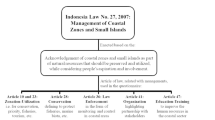Abstract
Tourism development may result in negative impacts on natural resources owing to overuse and mismanagement. However, tourism may also play positive roles in natural resource conservation, which has rarely been verified in practice, although some researchers have demonstrated this in theory. In this article, taking the Jiuzhaigou Biosphere Reserve as a case study area, we conducted an analysis for the environmental impacts from tourism development based on social survey and interpretation of remote sensing images. The results show that the natural environment was not degraded and some indicators are even improving because all the residents have participated in tourism and given up farming and hunting. It is concluded that it is possible to use tourism as a way to balance natural resource conservation and economic development under the preconditions of making effective policies to encourage and help local people participate in tourism business and to benefit from it.






Similar content being viewed by others
Literature Cited
Brown K., R. K. Turner, H. Hameed, I. Bateman. 1997. Environmental carrying capacity and tourism development in the Maldives and Nepal. Environmental Conservation 24:316–325
Burger J. 2000. Landscape, tourism and conservation. The Science of the Total Environment 249:39–49
Butler R. W. 1980. The concept of tourist area cycle of evolution. Canadian Geographer 24:5–12
Cater E. 1993. Ecotourism in the third world: problems for sustainable tourism development. Tourism Management 14:85–89
Ceballos-Lascurain H. 1996. Tourism, ecotourism and protected areas. Gland: IUCN Publication, 230 pp
Collins A. 1998. Tourism development and natural capital. Annals of Tourism Research 26:98–109
Dearden P., S. Harron. 1994. Alternative tourism and adaptive change. Annals of Tourism Research 21:81–102
Driml S., M. Common. 1996. Ecological criteria for sustainable tourism: application to the Great Barrier Reef and wet tropics world heritage areas, Australia. Journal of Sustainable Tourism 4:3–l6
Hawes, M. 1992. Draft walking track management strategy for the Tasinanian Wilderness World Heritage Area. Department of Parks, Wildlife and Heritage, Hobart
Jarvilouma J. 1992. Alternative tourism and the evolution of tourist areas. Tourism Management 13:118–120
Klemm M. 1992. Sustainable tourism development. Tourism Management 13:169–480
Kousis M. 2000. Tourism and the environment: a social movements perspective. Annals of Tourism Research. 27:468–489
Kuvan Y. 2005. The use of forests for the purpose of tourism: The case of Belek Tourism Center in Turkey. Journal of Environmental Management 75:263–274
Laiolo P. 2003. Diversity and structure of the bird community overwintering in the Himalayan subalping zone: Is conservation compatible with tourism? Biological Conservation 115:251–262
Li, W.-J. 2006. Community participation in nature reserve ecotourism: Experiences from the Jiuzhaigou Biosphere Reserve, China. Annals of Tourism Research (in press)
Li W-J., N. Han. 2001. Ecotourism management in China’s nature reserves. AMBIO 30:62–63
Lindberg K., J. Enriquez, K. Sproule. 1996. Ecotourism questioned: case studies from Belize. Annals of Tourism Research 23:543–562
Lonsdale W. M., A. M. Lane. 1994. Tourist vehicles as vectors of weed seeds in Kakadu National Park, Northern Australia. Biological Conservation 29:277–283
Lukashina N. S., M. M. Amirkhanov, V. I. Anisimov, A. Truner. 1996. Tourism and environmental degradation in Sochi, Russia. Annals of Tourism Research 23:654–665
Mbaiwa J. E. 2003. The socio-economic and environmental impacts of tourism development on the Okavango Delta, north-western Botswana. Journal of Arid Environments 54:447–467
McKercher B. 1993. The unrecognized threat to tourism: Can tourism survive sustainability. Tourism Management 14:131–136
Nash D., R. Butler. 1990. Alternative forms of tourism. International Journal of Hospitality Management 9:163–165
Nepal S. K. 2000. Tourism in protected areas: The Nepalese Himalayas. Annals of Tourism Research 27:661–681
North, A. 1991. Weeds on the central plateau: A survey of their distribution and association with recreational users. Department of Parks, Wildlife and Heritage Tasmania, Hobart
Prosser R. 1994. Societal change and the growth in alternative tourism. In E. Cater, G. Lowman (eds.), Ecotourism: A sustainable option John Wiley and Sons Ltd., New york, pages 19–37
Ross S., G. Wall. 1999. Ecotourism: Towards congruence between theory and practice. Tourism Management 20:123–132
SPAFS (Sichuan Provincial Academy of Forestry Sciences). 2004. Comprehensive scientific survey report of Jiuzhaigou Nature Reserve. P301. (In Chinese)
Stewart S., S. Sekartjakrarini. 1994. Disentangling ecotourism. Annals of Tourism Research 21:840–842
Sun D., D. Walsh. 1998. Review of studies on environmental impacts of recreation and tourism in Australia. Journal of Environmental Management 53:322–338
Sun D., M. J. Liddle 1993. A survey of trampling effects on vegetation and soil in eight tropical and subtropical sites. Environmental Management 17:495–510
Sun D., M. J. Liddle. 1991. Field occurrence, recovery and simulated trampling resistance and recovery of two grasses. Biological Conservation 57:187–203
Van der Duim R., J. Caalders. 2002. Biodiversity and tourism: Impacts and interventions. Annals of Tourism Research 29:743–761
Wallace G. N., S. N. Pierce. 1996. An evaluation of ecotourism in Amazonas, Brazil. Annals of Tourism Research 23:843–873
Weaver D. B. 1991. Alternative to mass tourism in Dominica. Annals of Tourism Research 18:414–432
Whinam J., M. Comfort. 1996. The impact of commercial horseriding on sub-alpine environments at Cradle Mountain, Tasmania. Australia Journal of Environmental Management 47:61–70
Wight P. 1993. Ecotourism:Ethics or eco-sell? Journal of Travel Research 31:3–9
Acknowledgments
This research was financially supported by National Nature Sciences Foundation of China (40271032). We would like to thank China MAB National Committee of UNESCO for arranging and coordinating all of the field surveys in Jiuzhaigou Biosphere Reserve during the past 4 years. The Jiuzhaigou County government, the administration of Jiuzhaigou Biosphere Reserve, and the local Tibetan community and indigenous people provided great help during our interview and field survey. We thank Dr. Janine Caalders and two other anonymous reviewers for their critical comments and suggestions, which helped greatly to improve the contents and presentation of this article.
Author information
Authors and Affiliations
Corresponding author
Rights and permissions
About this article
Cite this article
Li, W., Zhang, Q., Liu, C. et al. Tourism’s Impacts on Natural Resources: A Positive Case from China. Environmental Management 38, 572–579 (2006). https://doi.org/10.1007/s00267-004-0299-z
Published:
Issue Date:
DOI: https://doi.org/10.1007/s00267-004-0299-z




